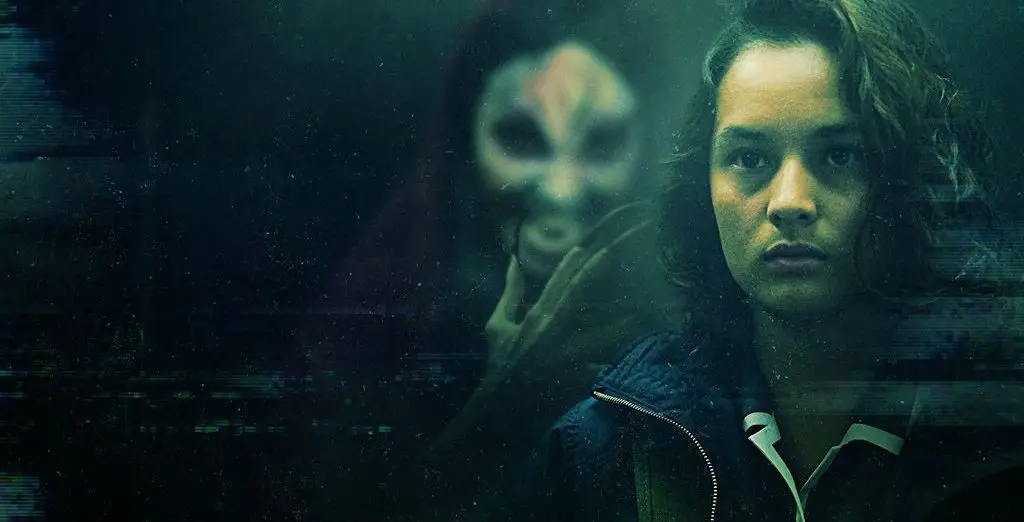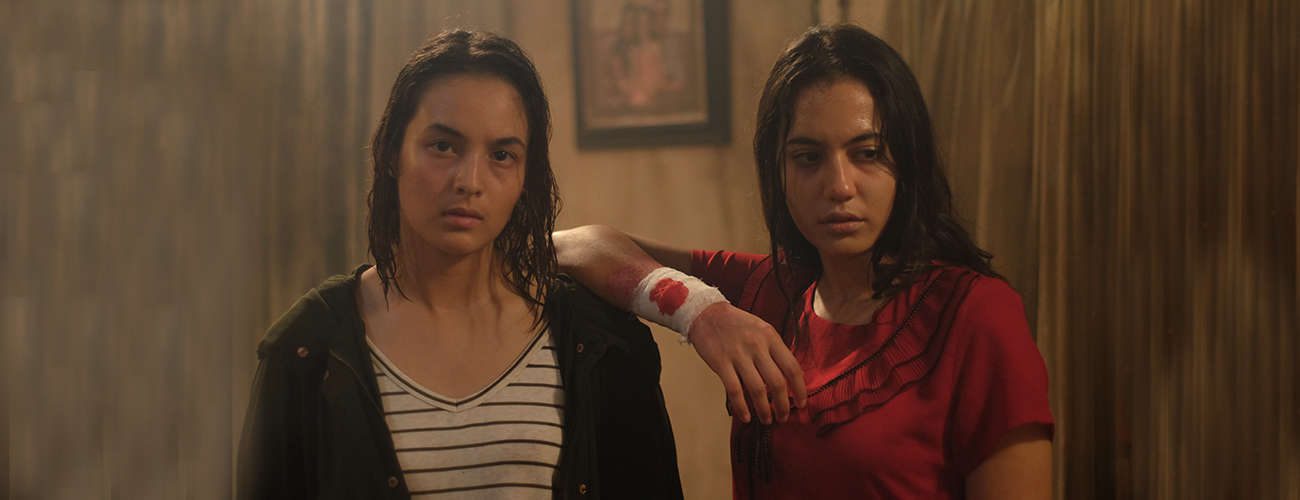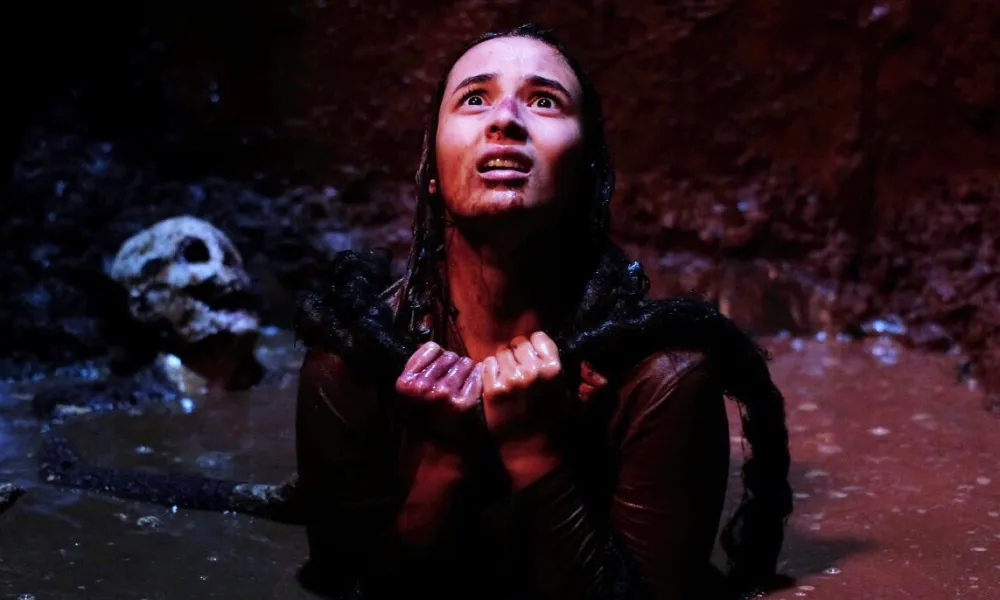For all its blood and gore, May the Devil Take You is a gutless horror movie. Timo Tjahjanto’s ode to Sam Rami’s Evil Dead movies lacks the kinetically gonzo over-the-top energy and tone. Odd, since the director’s action movies hue so close to those same adjectives. May the Devil Take You is a mare’s nest of a movie.
The problem is Tjahjanto’s script. Calling this hodgepodge of cliches and tropes a “script” is generous and possibly misleading. Horror movies require a certain amount of “suspension of disbelief”; it’s baked into the genre’s bones. One of the most significant concessions the audience must make is understanding that often characters will say and do abysmally stupid things; this is true in other genres. Still, in horror movies, it is practically a time-honored staple.

However, there is a limit before a character’s decisions and actions go from head-slapping to outright confounding. There’s “I wouldn’t do that,” and then there’s “No one would do that.” The characters make some of the most questionable choices based on the weakest logic since the dad went back into the house for the dog at the end of The Amityville Horror. However, in a post-pandemic world, the bar for human stupidity has been lowered to such a depressing degree that we often joke about how this very thing can no longer be used as a criticism of a movie.
But those people haven’t seen May the Devil Take You. I have.
Alfie (Chelsea Islan) returned to her father Lesmana’s (Ray Sahetapy) home. He is near death, so Alfie and her stepmother Laksmi (Karina Suwandi), her father’s third wife and an actress, have come along to see if anything can be sold. Lesmana was once a rich man but has fallen on hard times—no prizes for guessing how he became rich or why he lost his fortune.
Lakshmi is not alone; she’s brought the whole family. Alfie’s spoiled step-sister Maya (Pevita Pearce), her dorky step-brother Ruben (Samo Rafel), and her youngest step-sister Nara (Hadijah Shahab) have all come to pillage her father’s estate. The child, Nara, is another problem that plagues May the Devil Take You. But, unfortunately, she’s part of a larger problem: there are too many characters and not enough drama to go around.
Nara spends most of the movie off to the side of the screen or in peril, having minimal impact on the story at all. Worse, since she’s a child, there’s never any dread or horror in her scenes because Tjahjanto, despite his prediction of gore and finding ways to cover his actors in filth, is not the director who will kill a child. The result is the scenes involving the demons tormenting the child feel deflated as if Tjahjanto is killing time between set pieces.
Midway through the movie, Alfie and her family make it to the following day after a night of fighting demons and who knows what else. Then, inexplicably, Tjahjanto cuts to Alfie and her family sitting in the living room later that night. It’s then that one of them suggests trying to leave.
Characters split up and do so in a way that is confounding in who they choose to team up with. Add to this that the rules of May the Devil Take You are never made all that clear. If nothing happened during the day, then why not leave then? If something did happen during the day, then why not mention it? By stretching it out over a few days and having characters wait around before deciding to do something, Tjahjanto destroys any sense of tension.

It’s not merely the suspension of disbelief required but also how half-baked May the Devil Take You feels. There is a witch, voodoo dolls, pacts with the devil, welching on debts made to the dark lord of the underworld-never a wise decision, and a general sense that nobody, least of all Tjahjanto, knows what’s going on. Worse is that all this chaos comes without any cinematic zest.
May the Devil Take You takes place mainly in a house in the middle of the woods where a family fights a losing battle against possessed corpses, demons, and other terrors, and yet, Tjahjanto and his trusted cameraman Batara Goempar telegraphs almost every jump scare. The two made this year’s The Big 4 a movie I enjoyed.
Their collaboration in that one had a zest, a tactile sense of looney-tunes physicality that is desperately lacking in May the Devil Take You. However, every once and a while, Tjahjanto and Goemper pull a rabbit out of their hat. Take the tired old scene of Laksmi standing in front of the open cellar door, a ghoulish face peering out of the blackness, the camera low to the ground so it’s framed between her legs.
We know the demon will reach out, grab her, and pull her into the dark. If you’ve ever seen a horror movie about haunted houses, demons, ghosts, or what have you, you’ve seen this scene. Usually, the scene would be sped up or edited to be disorienting, often even with flashing lights and an obnoxious score. But Tjahjanto and Goemper find new life in the scene simply by shooting it head-on.
By doing this, holding the camera back and watching the demon reach out to grab her in real-time, seeing her crawl and fight as she’s dragged into the basement, Tjahjanto and Goemper force us to watch the horror. Lakshmi’s nails digging into the wooden floor as she scrambled to pull away had me wrapped up in a ball.
The most irritating thing about May the Devil Take You is that parts of it work and work so well that it only highlights how much nothing else works. For example, at one point, a character rips her face off to reveal a demon’s face underneath, and it had me practically crawling up the wall. In these moments, Tjahjanto reminds you he’s a maestro at making his viscera feel visceral.

But for every moment that works, there are five that don’t. An air of nothingness permeates May the Devil Take You—a lack of tone and atmosphere. We’re never sure of the geography of the house Alfie and her family are in, and while that could aid in keeping the audience uneasy and unsure about where anything is, it mostly succeeds in keeping us confused and lost.
I’ve enjoyed Tjahjanto’s other works, but May the Devil Take You left me cold. All his hallmarks are there, the inventive gore and crisp action sequences, while also reviling in covering his actors in filth. One scene towards the end has Alfie covered in blood, mud, and guts that feel like vintage Rami and Tjahjanto. Pity nothing else did.
Images courtesy of Netflix
Have strong thoughts about this piece you need to share? Or maybe there’s something else on your mind you’re wanting to talk about with fellow Fandomentals? Head on over to our Community server to join in the conversation!

